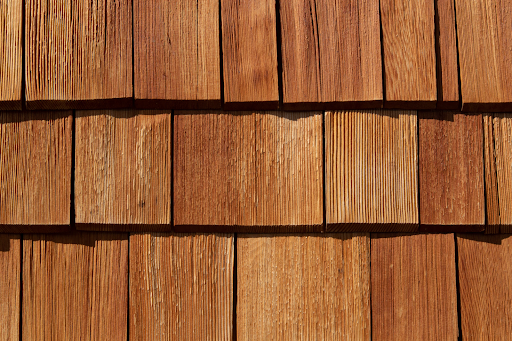How to Maintain and Care for Your Wood Roof: Tips for Longevity

What is a wood roof?
A wood roof is a classic and elegant way to adorn your home. It’s not just a layer of wood shingles–it’s a carefully crafted system designed to provide protection and beauty for decades.
For centuries, wood has graced the roofs of countless homes, imbuing them with a unique charm and natural beauty. From the warm, inviting aesthetic of cedar shakes to the timeless elegance of slate shingles, wood roofs offer a distinct character that complements a variety of architectural styles. However, to ensure your wood roof endures the test of time, it’s crucial to implement a regular maintenance plan.
Wood Roofs: Charm, Appeal, and Unmatched Character
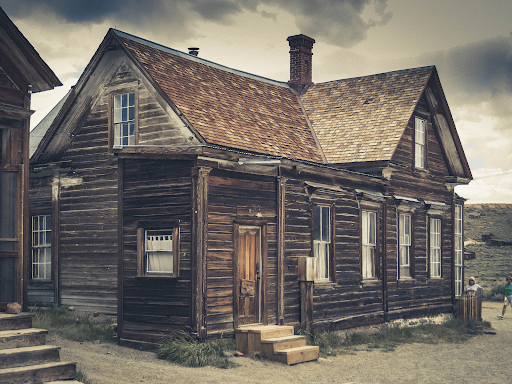
Wood roofs offer a multitude of benefits, including
- Unmatched Beauty: Wood’s natural texture and warmth bring a distinct charm to any home, enhancing its curb appeal and evoking a sense of timelessness.
- Durability: When properly maintained, wood roofs can last for decades, providing lasting protection from the elements.
- Insulation: Wood is a natural insulator, helping to keep your home cooler in the summer and warmer in the winter, leading to improved energy efficiency.
- Environmentally Friendly: Wood is a renewable resource, and it can be recycled or repurposed at the end of its lifespan.
- Beyond Aesthetics: The appeal of wood roofs extends beyond their visual beauty. They offer a number of practical benefits, including:
- Superior Soundproofing: Wood’s natural soundproofing properties help to reduce noise pollution inside the home.
- Fire Resistance: While the inherent fire resistance of wood varies depending on the species and treatment, many wood roof options are treated with fire retardants for enhanced safety.
- Proper Drainage: The textured surface of wood roofs allows for effective water drainage, minimizing the risk of leaks and water damage.
The Importance of Regular Maintenance for Wood Roof Longevity

Wood roofs offer a unique charm and character to homes, but their beauty and functionality can only be sustained with proper care. Regular maintenance is essential to ensure your wood roof reaches its full lifespan, protecting your home from the elements and preventing costly repairs. Here’s why:
1. Preventing Moisture Damage
Wood is naturally susceptible to moisture damage, which can lead to rot, decay, and ultimately roof failure. Regular inspections and cleaning help identify and remove debris, leaves, and moss buildup that trap moisture. Clearing gutters and ensuring proper ventilation also play a crucial role in preventing moisture accumulation.
2. Early Detection of Problems
Regular maintenance allows you to identify minor issues like missing or damaged shingles, loose flashing, or signs of rot and insect infestation early on. Addressing these problems promptly prevents them from developing into major structural issues that require extensive and expensive repairs.
3. Extending Lifespan
With proper care, wood roofs can last for decades, exceeding the lifespan of many other roofing materials. Regular maintenance helps prevent premature wear and tear, ensuring your roof continues to function effectively and protect your home for years to come.
4. Enhancing Curb Appeal
A well-maintained wood roof retains its natural beauty and warmth, adding significant curb appeal to your property. Regular cleaning removes algae streaks and other discolorations, allowing the wood’s natural grain and texture to shine through. Additionally, timely repairs prevent the roof from developing an unkempt appearance.
5. Maintaining Warranty Coverage
Many wood roof manufacturers require regular maintenance to uphold the warranty’s terms. Failing to meet these requirements could void the warranty, leaving you responsible for the full cost of any repairs.
Types of Wood Roofs
A. Cedar Wood Roofs
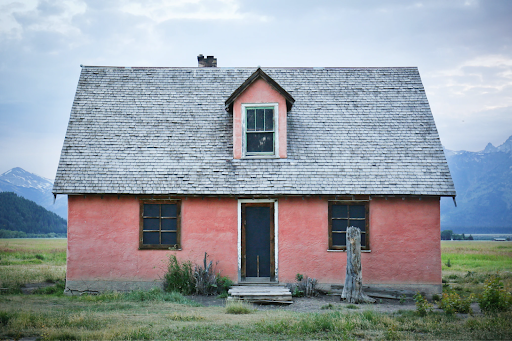
1. Characteristics and benefits
- Durability: Cedar wood is naturally resistant to rot, decay, and insect infestation, allowing cedar roofs to last for decades with proper maintenance.
- Beauty: Cedar’s natural grain and color variations add a unique charm and warmth to any home.
- Lightweight: Compared to other roofing materials like slate, cedar is lighter, reducing the burden on your home’s structure.
- Insulation: Cedar offers excellent thermal insulation, helping to keep your home cooler in the summer and warmer in the winter, potentially reducing energy costs.
- Sustainability: Cedar is a renewable resource, making it a more environmentally friendly choice than some other roofing options.
-
- Cedar Shakes: Hand-split with a rough, rustic texture, ideal for a natural and textured aesthetic.
- Cedar Shingles: Sawn lumber with a smooth, uniform appearance, suitable for a more traditional and polished look.
2. Considerations for maintenance specific to cedar wood
- Susceptible to moisture damage: While naturally resistant, cedar can still be affected by moisture. Regular cleaning and maintenance are crucial to prevent rot and decay.
- Fire risk: Cedar is naturally flammable, so it’s important to choose fire-retardant treated wood and adhere to local fire codes.
- Regular inspections and cleaning: Inspect your cedar roof annually for missing or damaged shingles, moss buildup, and signs of moisture damage. Remove debris and clean the roof surface to prevent further problems.
- Re-sealing: Depending on your climate and the type of cedar used, you may need to re-seal your roof every few years to maintain its water resistance.
- Professional help: For more complex maintenance tasks or installations, consult a qualified roofing contractor experienced with cedar roofs.
B. Wood Shake Roofs
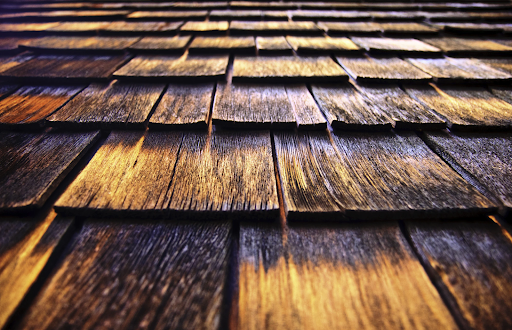
1. Features and Advantages
Wood shake roofs are known for their rustic charm and natural beauty. They offer a unique and eye-catching aesthetic that complements many architectural styles. Here are some of the key features and advantages of wood shake roofs:
- Distinctive Appearance: Wood shakes are hand-split and exhibit a rough, textured surface, creating a distinctively natural and rustic appearance.
- Durability and Longevity: When properly maintained, wood shake roofs can last for decades, often exceeding the lifespan of other roofing materials.
- Insulation and Energy Efficiency: Wood’s natural insulating properties help regulate temperatures within your home, potentially reducing energy consumption and costs.
- Soundproofing: The textured surface of wood shakes helps absorb sound, reducing noise pollution inside your home.
- Environmentally Friendly: Wood is a renewable resource, and many wood shakes are manufactured using salvaged or recycled wood, reducing their environmental impact.
- Variety of Style Options: Wood shakes come in a range of wood species, colors, and textures, allowing homeowners to personalize their roofs and achieve the desired aesthetic.
2. Unique Maintenance Requirements for Wood Shake Roofs
While wood shake roofs offer numerous advantages, they also require specific maintenance considerations due to their natural properties and textured surface. Here are some unique maintenance requirements for wood shake roofs:
- Regular Cleaning: Wood shake roofs are susceptible to moss and algae growth, requiring more frequent cleaning compared to other roofing materials. Aim to clean your wood shake roof every 1-2 years.
- Moisture Management: Due to their textured surface, wood shakes can trap moisture and debris. Regular inspections and cleaning are crucial to prevent moisture buildup and subsequent rot or decay.
- Ventilation: Proper ventilation is essential for wood shake roofs to ensure moisture escapes efficiently. Ensure your roof has adequate ventilation through soffits and vents.
- Re-sealing: Depending on your climate and the type of wood used, you may need to re-seal your wood shake roof every 5-10 years to maintain its water resistance.
- Professional Installation: Wood shake roofs require specialized skills and knowledge for proper installation. Consider hiring a qualified roofing contractor experienced with wood shakes to ensure long-term performance.
C. Redwood Roofing
Redwood roofs have long graced homes with their natural beauty and impressive durability. This wood species stands out with its distinctive qualities, making it a unique and desirable roofing option.
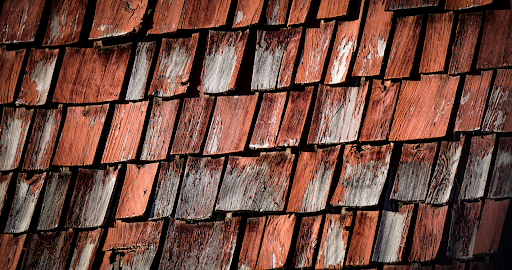
1. Exploring the Distinctive Qualities of Redwood
- Strength and Longevity: Redwood boasts exceptional strength and resistance to decay, rot, and insects, making it one of the most durable roofing materials available. Redwood roofs can last for generations with proper care, often exceeding 50 years.
- Fire Resistance: Redwood’s natural fire resistance surpasses many other wood species, offering a valuable safety advantage.
- Natural Beauty: Redwood’s warm, natural color and unique grain patterns add a timeless elegance and charm to any home. As it ages, redwood develops a silvery patina, further enhancing its beauty and character.
- Insulation and Energy Efficiency: Redwood’s natural insulating properties help regulate temperatures within your home, potentially reducing energy consumption and costs.
- Environmental Sustainability: Redwood is a slow-growing species harvested from sustainably managed forests, making it a more environmentally friendly choice compared to some other roofing materials.
2. Tips for Caring for Redwood Roofs
While redwood roofs are known for their durability, proper care is still crucial to maximize their lifespan and preserve their beauty. Here are some essential tips for caring for your redwood roof:
- Regular Inspections: Conduct an inspection annually, checking for missing or damaged shingles, signs of rot or decay, and any potential issues with flashing or ventilation.
- Cleaning: Remove leaves, debris, and moss buildup from the roof surface regularly, as this can trap moisture and lead to rot. Use a soft brush to avoid damaging the shingles.
- Trimming: Trim overhanging branches to prevent them from scratching the roof surface and creating pathways for pests.
- Gutters: Ensure your gutters are clean and free of debris to allow proper drainage. Clogged gutters can cause water to back up and damage the roof.
- Repairs: Address any minor issues promptly, such as replacing missing or damaged shingles. Ignoring repairs can lead to more extensive and costly problems down the line.
- Sealing: Depending on your climate, you may need to apply a sealant to the roof every few years to maintain its water resistance.
- Professional Assistance: For complex repairs or maintenance tasks, consider consulting a qualified roofing contractor experienced with redwood roofs.
Wood Roof Repair
Even the most well-maintained wood roof can experience wear and tear over time, requiring repair to maintain its functionality and protect your home. Here’s a guide to identifying two of the most common wood roof issues:
A. Identifying Common Issues
1. Shingle Damage
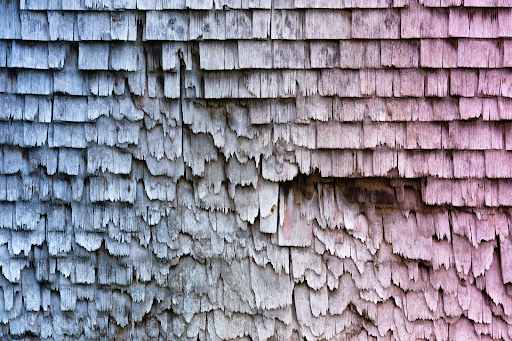
This is the most common issue affecting wood roofs. Shingle damage can manifest in various ways:
- Missing or curled shingles: These can expose your roof deck to the elements, leading to moisture damage and potential leaks.
- Cracked or split shingles: These can also allow water to penetrate and cause further deterioration.
- Loose or lifted shingles: These can be blown off by wind, exposing the roof deck and creating gaps.
- Blistered shingles: These contain air pockets that can trap moisture and eventually lead to rot.
- Granule loss: Over time, the protective granules on shingles wear away, exposing the underlying asphalt and making the roof more susceptible to damage.
Signs of shingle damage include:
- Visible gaps or holes in the roof surface.
- Water stains on the ceiling or walls.
- Granules accumulating in gutters or downspouts.
- Increased noise from rain or wind.
- Curling or flapping shingles.
2. Rot and Decay
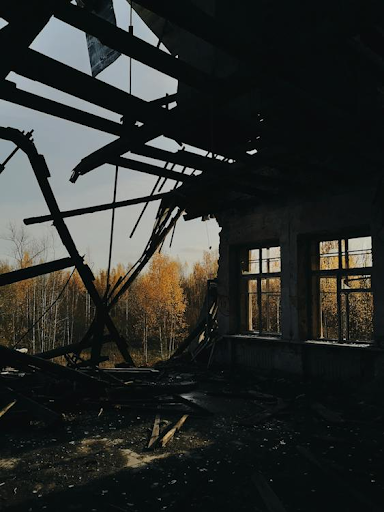
Wood is naturally susceptible to rot and decay, especially when exposed to moisture for extended periods. This can occur due to several factors, including:
- Leaks: Leaking roofs allow water to penetrate the wood, creating ideal conditions for rot and decay.
- Poor ventilation: Insufficient ventilation traps moisture within the roof structure, accelerating decay.
- Clogged gutters: Clogged gutters prevent proper drainage, leading to water pooling around the roof and increasing the risk of rot.
- Inadequate flashing: Improper flashing around vents, chimneys, and other roof penetrations can allow water to seep in and cause rot.
- Debris accumulation: Leaves, branches, and other debris can hold moisture against the wood, promoting rot and decay.
Signs of rot and decay include:
- Soft, spongy wood.
- Discolored wood.
- Crumbling or flaking wood.
- Mushrooms or other fungal growth.
- Visible gaps or holes in the roof deck.
B. DIY Repairs (vs) Professional Assistance: When to Tackle and When to Call in the Pros
While some minor repairs on your wood roof can be tackled as a DIY project, others require the expertise and skills of a professional roofing contractor. Here’s a guide to help you determine when DIY repairs are feasible and when professional assistance is necessary:
1. When to Tackle Small Repairs on Your Own
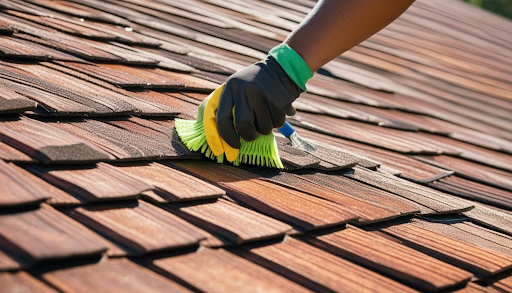
- Missing or loose shingles: These can be replaced with new shingles that match the existing ones. Ensure you use the correct type of nails and follow proper installation techniques.
- Minor cracks or splits: These can be repaired using a patching compound specifically designed for wood roofs.
- Cleaning and debris removal: Regularly removing leaves, branches, and other debris from your roof can help prevent moisture buildup and potential problems.
- Sealing: Applying a sealant to your roof every few years can help maintain its water resistance and extend its lifespan.
Resources for DIY repairs
- This Old House: https://m.youtube.com/watch?v=y-mwVZaNfm0
- Family Handyman: https://home.howstuffworks.com/home-improvement/repair/how-to-repair-a-leaky-roof3.htm
- The Spruce: https://m.youtube.com/watch?v=h8zVA1357os
2. Signs that a Professional is Needed
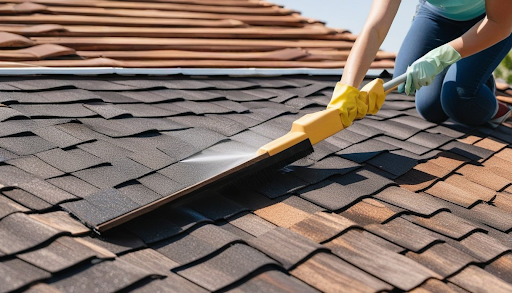
- Extensive shingle damage: If a large number of shingles are missing, damaged, or curled, it’s best to call a professional. Replacing a significant portion of the roof requires expertise and specialized tools.
- Rot and decay: Repairing rot and decay requires removing the affected areas and replacing them with new wood. This is a complex process that should be entrusted to a qualified roofer.
- Leaks: Locating and repairing leaks can be challenging, and improper fixes can lead to further damage. A professional roofer has the experience and tools to identify the source of the leak and perform the necessary repairs.
- Structural damage: If your roof deck or supporting structures are damaged, it’s crucial to seek professional help immediately. This type of repair requires knowledge of building codes and proper construction techniques.
- Safety concerns: Working on a roof can be dangerous, especially if you are not experienced. If you have any concerns about your safety, it’s always best to hire a professional.
Benefits of hiring a professional
- Experience and expertise: Professional roofers have the knowledge and skills to diagnose and repair any roof problem effectively.
- Quality results: They use the correct materials and techniques to ensure your roof is repaired to a high standard.
- Time-saving: Hiring a professional can save you time and effort, allowing you to focus on other tasks.
- Safety: Professionals are trained to work safely on roofs, minimizing the risk of accidents.
- Warranty: Many professional roofers offer warranties on their work, giving you peace of mind.
Embrace the Enduring Charm of Wood Roofs
Owning a wood roof is an investment in beauty, sustainability, and enduring charm. With proper care and maintenance, your wood roof can be a cherished element of your home for generations to come. By implementing the tips and information shared in this guide, you can ensure your wood roof reaches its full potential, offering protection, beauty, and character for years to come.
Remember, whether you choose to tackle minor repairs yourself or entrust your roof to a professional, the most important thing is to prioritize safety and responsible practices. Enjoy the unique charm and warmth of your wood roof, and let it continue to be a treasured part of your home’s story.
References
- Cedar Shake & Shingle Bureau: https://directcedarsupplies.com/cedar-shake-and-shingle-bureau-the-rules-and-the-secret-to-the-labels/
- Asphalt Roofing Manufacturers Association: https://www.asphaltroofing.org/
- National Roofing Contractors Association: https://www.nrca.net/
- This Old House: https://www.youtube.com/watch?v=BbAUm0qZ2RI
- Cedar Shake & Shingle Bureau: https://directcedarsupplies.com/
- Western Red Cedar Lumber Association: https://forresweb.com/western-red-cedar-lumber-association-wrcla/
- Cedar Roofing Maintenance Guide: https://cedarshakesroofcleaning.com/proper-care-and-maintenance-of-wood-shingle-and-shake-roofs/
- Cedar Shake & Shingle Bureau: https://directcedarsupplies.com/cedar-shake-and-shingle-bureau-the-rules-and-the-secret-to-the-labels/
- Western Red Cedar Lumber Association: http://www.wrcla.com/
- Wood Shake Roofing Maintenance Guide: https://cedarshakesroofcleaning.com/
- Cedar Shake & Shingle Bureau: https://directcedarsupplies.com/
- Asphalt Roofing Manufacturers Association: https://www.asphaltroofing.org/
- National Roofing Contractors Association: https://www.nrca.net/

